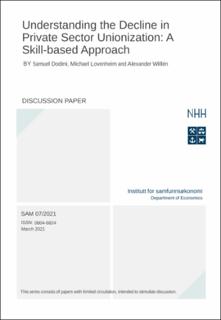Understanding the Decline in Private Sector Unionization: A Skill-based Approach
Working paper

Åpne
Permanent lenke
https://hdl.handle.net/11250/2732885Utgivelsesdato
2021-03Metadata
Vis full innførselSamlinger
- Discussion papers (SAM) [657]
Sammendrag
Private-sector unionization rates have fallen precipitously in the United States over the past half century, from 25% in 1973 to only 7% in 2018. We take a skill-based approach to studying this decline, using data from the Current Population Survey combined with occupation-specific task requirements from the Dictionary of Occupational Titles and the Occupational Information Network. We find that for both men and women, private sector unionized jobs became higherskilled by requiring more non-routine, cognitive skills and fewer manual or routine skills. We further show that union, non-union skill differences have polarized, with unionized worker occupations becoming relatively more intensive in non-routine, cognitive skills and in manual/routine skills. These changes have been more pronounced for women than for men. Next, we decompose these skill changes into three parts: (1) changes in skills within an occupation, (2) changes in worker concentration across existing occupations, and (3) changes to the occupational mix from both entry and exit. Most of the skill changes we document are driven by the second two forces. The third part of the analysis estimates union wage premiums that account for changing skill mix. We find that accounting for skills has a small effect on the union wage premium and that the premium remains high at over 20% for both men and women. Finally, we show how this evidence can be reconciled with a model of skill-biased technological change that explicitly accounts for the institutional framework surrounding collective bargaining.